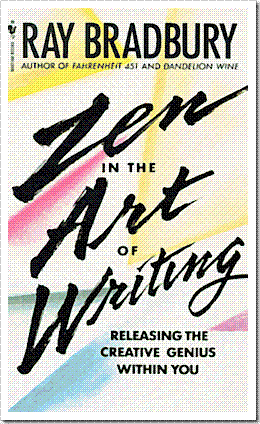 It’s not like anyone can really teach you how to write. The craft part of writing is like any other job. It’s like driving a bus or programming java. It soon gets old quickly. I know a few writers who think that writing for money every day is deathly boring and soul sucking.
It’s not like anyone can really teach you how to write. The craft part of writing is like any other job. It’s like driving a bus or programming java. It soon gets old quickly. I know a few writers who think that writing for money every day is deathly boring and soul sucking.
Creative writing, however, is one of those things that you are compelled to do, whether you want to or not. Zen in the Art of Writing is not a writing manual, a guide to writing, a book of tips and tricks or even a book advice to the wannabee writer. It is a book about Bradbury’s love of writing.
Bradbury has written about a thousand words a day since he was 12. He didn’t sell anything until he was 20, and he remembers clearly writing The Lake, his first real story, as an almost religious experience. He says the tears were streaming off the tip of nose and onto the typewriter as he finished.
Zen in the Art of Writing is a collection of ten essays and a preface written at different times in Ray’s career. How to Keep and Feed a Muse, the earliest, was published in 1961. Run Fast, Stand Still, or, The Thing at the Top of the Stairs, or, New Ghosts From Old Minds, the most recent essay, was published in 1986. The book itself is from 1990. (My copy is signed by Bradbury). It is a short work, about 50k. I read most of it on the bus this morning.
I found all the essays worth reading, with the caveat that reading them won’t tell you how to write. The essay entitled Drunk and in Charge of a Bicycle the most fun because it explained in a little detail how he came up with the ideas for some of his stories.
For instance the Foghorn, a compelling story, is described:
One night my wife and I were walking along the beach in Venice, California, where we lived in a thirty-dollars-a-month newlyweds’ apartment,we came on the bones of the Venice pier and the struts, tracks, and ties of ancient roller-coaster collapsed on the sand and being eaten by the sea.
"What’s that Dinosaur doing lying here on the beach?" I said.
Bradbury woke in the middle of the night with the answer. The Santa Monica Bay foghorn was sounding.
Of course, I thought, the dinosaur heard that lighthouse foghorn blowing, thought it was another dinosaur arisen from the deep past, came swimming for a loving confrontation, discovered it was only a fog horn, and died of a broken hearth there on the shore.
Bradbury wrote the story that night and sent it the next day to the Saturday Evening Post, where they bought it.
A few months later, my grandfather, who subscribed to the Saturday Evening Post, read The Foghorn and remembered it. Years later when Grandpa saw me reading a Ray Bradbury book, he asked me if I had read The Foghorn. "Good Story" he said.
One thing that Bradbury does that may help a writer is to start on a blank page doing word associations. He keeps a list of pregnant phrases that might lead to stories. He starts with one of them doing free associations of words and ideas and often wanders into a story. He follows the story while he is writing as though he were actually reading it and is often surprised at how it ends. Some of his best stories were written this way.
Bradbury writes that he typically does seven rewrites of a story. This, of course, was before word processors, so he just didn’t edit a story, he started at the beginning and wrote the story again. He had the advantage of being able to borrow words, phrases and even paragraphs from the previous versions, but each rewrite was a creative experience where he would extend or compress or explore the story in a different way.
Bradbury also wrote that he sometimes writes a story in a fever, puts it in an envelope and mails it out immediately on finishing. He doesn’t say which method produces the best stories.